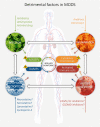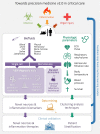Paving the way for precision medicine v2.0 in intensive care by profiling necroinflammation in biofluids
- PMID: 30201975
- PMCID: PMC6294775
- DOI: 10.1038/s41418-018-0196-2
Paving the way for precision medicine v2.0 in intensive care by profiling necroinflammation in biofluids
Abstract
Current clinical diagnosis is typically based on a combination of approaches including clinical examination of the patient, clinical experience, physiologic and/or genetic parameters, high-tech diagnostic medical imaging, and an extended list of laboratory values mostly determined in biofluids such as blood and urine. One could consider this as precision medicine v1.0. However, recent advances in technology and better understanding of molecular mechanisms underlying disease will allow us to better characterize patients in the future. These improvements will enable us to distinguish patients who have similar clinical presentations but different cellular and molecular responses. Treatments will be able to be chosen more "precisely", resulting in more appropriate therapy, precision medicine v2.0. In this review, we will reflect on the potential added value of recent advances in technology and a better molecular understanding of necrosis and inflammation for improving diagnosis and treatment of critically ill patients. We give a brief overview on the mutual interplay between necrosis and inflammation, which are two crucial detrimental factors in organ and/or systemic dysfunction. One of the challenges for the future will thus be the cellular and molecular profiling of necroinflammation in biofluids. The huge amount of data generated by profiling biomolecules and single cells through, for example, different omic-approaches is needed for data mining methods to allow patient-clustering and identify novel biomarkers. The real-time monitoring of biomarkers will allow continuous (re)evaluation of treatment strategies using machine learning models. Ultimately, we may be able to offer precision therapies specifically designed to target the molecular set-up of an individual patient, as has begun to be done in cancer therapeutics.
Conflict of interest statement
The authors declare that they have no conflict of interest.
Figures



Similar articles
-
The coming era of precision medicine for intensive care.Crit Care. 2017 Dec 28;21(Suppl 3):314. doi: 10.1186/s13054-017-1910-z. Crit Care. 2017. PMID: 29297399 Free PMC article. Review.
-
The future of Cochrane Neonatal.Early Hum Dev. 2020 Nov;150:105191. doi: 10.1016/j.earlhumdev.2020.105191. Epub 2020 Sep 12. Early Hum Dev. 2020. PMID: 33036834
-
Are innovation and new technologies in precision medicine paving a new era in patients centric care?J Transl Med. 2019 Apr 5;17(1):114. doi: 10.1186/s12967-019-1864-9. J Transl Med. 2019. PMID: 30953518 Free PMC article. Review.
-
Biomarkers of gut barrier failure in the ICU.Curr Opin Crit Care. 2016 Apr;22(2):152-60. doi: 10.1097/MCC.0000000000000283. Curr Opin Crit Care. 2016. PMID: 26808138 Review.
-
Non-Invasive Biomarkers in the Era of Big Data and Machine Learning.Sensors (Basel). 2025 Feb 25;25(5):1396. doi: 10.3390/s25051396. Sensors (Basel). 2025. PMID: 40096210 Free PMC article. Review.
Cited by
-
The Role of Adipokines as Circulating Biomarkers in Critical Illness and Sepsis.Int J Mol Sci. 2019 Sep 28;20(19):4820. doi: 10.3390/ijms20194820. Int J Mol Sci. 2019. PMID: 31569348 Free PMC article. Review.
-
Ferroptosis and pyroptosis signatures in critical COVID-19 patients.Cell Death Differ. 2023 Sep;30(9):2066-2077. doi: 10.1038/s41418-023-01204-2. Epub 2023 Aug 15. Cell Death Differ. 2023. PMID: 37582864 Free PMC article.
-
Can Big Data and Machine Learning Improve Our Understanding of Acute Respiratory Distress Syndrome?Cureus. 2021 Feb 24;13(2):e13529. doi: 10.7759/cureus.13529. Cureus. 2021. PMID: 33786236 Free PMC article. Review.
-
Dynamical modeling of pro- and anti-inflammatory cytokines in the early stage of septic shock.In Silico Biol. 2020;14(1-2):101-121. doi: 10.3233/ISB-200474. In Silico Biol. 2020. PMID: 32597796 Free PMC article.
-
DNA-Based Biomaterials for Immunoengineering.Adv Healthc Mater. 2019 Feb;8(4):e1801243. doi: 10.1002/adhm.201801243. Epub 2018 Dec 5. Adv Healthc Mater. 2019. PMID: 30516349 Free PMC article. Review.
References
-
- Colombo M, Annoni G, Donato MF, Conte D, Martines D, Zaramella MG, et al. Serum type III procollagen peptide in alcoholic liver disease and idiopathic hemochromatosis: its relationship to hepatic fibrosis, activity of the disease and iron overload. Hepatology. 1985;5:475–9. doi: 10.1002/hep.1840050322. - DOI - PubMed
-
- Virchow R. Cellular pathology: as based upon physiological and pathological histology: twenty lectures delivered in the Pathological Institute of Berlin During the Months of February, March and April, 1858. 1860.
Publication types
MeSH terms
Substances
LinkOut - more resources
Full Text Sources
Other Literature Sources
Medical

